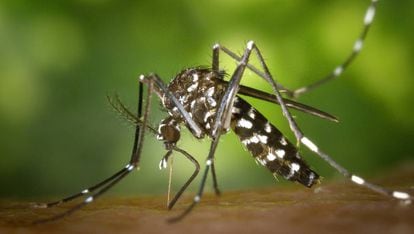The new invasive mosquito species spreading ‘like an oil stain’ in Spain
Scientists warn the ‘Aedes japonicus’ has great potential to expand because it can adapt to cold weather and breed “in a wide range of aquatic habitats”
/cloudfront-eu-central-1.images.arcpublishing.com/prisa/NW74W4PKINHX5D33TUMLKF23UQ.jpg)

The Asian tiger mosquito was the first member of the Aedes genus to take up residence in the Iberian peninsula, where it soon became a regular summer nuisance, particularly along the Mediterranean coast. It was first detected in 2004 in Barcelona province, and has since spread at a fast pace.
But it may not be the only airborne pest moving across the peninsula.
Since 2018, the small northern regions of Asturias and Cantabria have been home to another invasive mosquito species, Aedes japonicus. Although it is more discreet than the tiger mosquito because it favors fields with cattle over urban areas, its potential for expansion is even greater.
“Aedes japonicus caught us by surprise because we didn’t see it coming, and we also don’t know how it got here,” explains Javier Lucientes, a professor at Zaragoza University who heads the Health Ministry’s entomology surveillance project.
Aedes japonicus caught us by surprise because we didn’t see it coming, and we also don’t know how it got hereJavier Lucientes, Zaragoza University
A new field study has been planned for this summer to assess the spread of this new species in Asturias and Cantabria. Experts suspect that by now, it may have entered neighboring Galicia as well. Lucientes says it is too late to eradicate the Asian bush mosquito, as it is commonly known in English, and that in the coming years it will probably extend “like an oil stain” into the regions of Castilla y León, the Basque Country and Navarre.
Its growth could be greater than that of the tiger mosquito because it adapts better to cold weather, and because it can breed “in a wide range of aquatic habitats, such as puddles, tires, milk cartons or buckets,” according to the Health Ministry. “It is less discerning than Aedes albopictus (tiger mosquito), which could facilitate its expansion.”
Frederic Bartumeus, a researcher at the Spanish National Research Council’s Blanes Center for Advanced Studies (CEAB-CSIC), says that the tiger mosquito spreads along the main roadways, often hitching a ride inside vehicles, while the bush mosquito expands “in little jumps.”
It was detected in the early 21st century in central Europe, and scientists were amazed at its ability to spread across vast stretches of land. “It was identified in Switzerland in 2008 and subsequent research found that it had colonized an area covering 1,400 square kilometers,” says a 2018 report from the Spanish Health Ministry’s Coordination Center for Health Alerts and Emergencies.
The used-tire trade route

This agency notes that Aedes japonicus comes from east Asia and began its global spread in the 1990s through the international trade in used tires. This species not only lays eggs in the water, but also on dry surfaces that could later collect water, such as the inside of tires.
The region of Asturias, located on Spain’s northern coast, first showed up on the European Center for Disease Prevention and Control’s (ECDC) bush mosquito tracking map in August 2019. But the first alert came in July 2018, when a local man from Siero, a hamlet near the city of Oviedo, took a picture of a specimen and shared it on a cellphone app called Mosquito Alert.
The program, which is run by several public agencies, was created in 2014 mainly to follow the spread of the tiger mosquito in Spain thanks to input by the more than 74,000 people who have downloaded the app. Bartumeus, who heads the Mosquito Alert initiative, says that one of their priorities is detecting potential invasive species from the Aedes genus. There are already five of them in Europe, and Spanish researchers are concerned about the potential arrival of Aedes aegypti, or yellow fever mosquito.
West Nile virus
Aedes japonicus represents a lower risk to humans than Aedes aegypti, the main vector for the dengue fever. So far this latter mosquito has not been detected in Spain. In 2018, the Spanish Health Ministry concluded that the risk of disease transmission by the bush mosquito is “very low,” although it did concede that it could transmit dengue or Chikungunya fever.
Lucientes notes that Aedes japonicus is, however, an important vector for the West Nile virus, which mostly affects the nervous system of birds and horses. The disease is already present in Spain, and can cause symptoms “like a summer flu, while some people can suffer from encephalitis,” says Lucientes.
Unlike the tiger mosquito and the yellow fever mosquito, the bush mosquito prefers natural areas with lots of vegetation. “One advantage to this is that, because it breeds in forest settings, it may have more predators in breeding areas,” says Miguel Ángel Miranda, who teaches zoology at the University of the Balearic Islands. It was Miranda who first located a specimen in the Santander area, in Cantabria, in 2018.
“It is less discerning than Aedes albopictus (tiger mosquito), which could facilitate its expansion”Spanish Health Ministry
“I ran into one at a watering trough made of stone, across from a shrine,” he recalls with a smile. “I was visiting the area with relatives, and while we were having something to eat, I took a little walk and located some larvae that caught my eye. We entomologists are always alert.”
During two field missions by the Lucientes and Mosquito Alert team, what researchers noticed the most is the bush mosquito’s predilection for cattle drinking areas.
“They just love to breed inside old tubs used as watering troughs for animals,” notes Bartumeus, who says it is up to local authorities to keep residents informed and take measures such as cleaning the troughs and applying larvacide. “As we have seen in other European countries, eradicating them is very difficult.”
“It is vital to control the breeding areas,” adds Miranda, who agrees that local and regional authorities should take action. “Up until now, as far as I know, nothing has been done.”
A spokeswoman at the regional health department of Asturias said that in 2019, a team from the Epidemiology Surveillance Service set traps to detect tiger mosquito clusters, and chanced upon specimens of Aedes japonicus in watering troughs for cows. But regional technicians did not feel it was of any consequence from a health point of view, said this spokesperson.
Lucientes and Miranda note that Aedes japonicus has probably been in Spain for too short a time to have made authorities really sit up and take notice. As a matter of fact, the mosquito doesn’t even have a name in Spanish yet.
English version by Susana Urra.












































